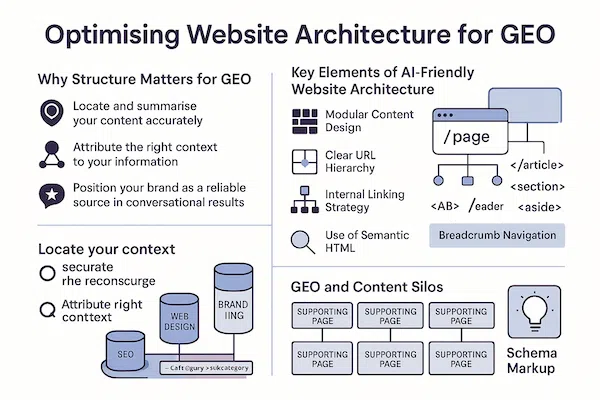Sunday, August 10, 2025 |
Brief Overview:
This article explores how to optimise your website’s structure to better serve generative AI systems. From URL hierarchy and content silos to semantic HTML and internal linking, you’ll learn the architectural foundations that support both traditional SEO and the newer demands of GEO.
Why Structure Matters for GEO
For years, marketers have structured websites to help humans and search engines find and interpret content. With generative engines like ChatGPT and Google SGE, the stakes are higher: AI models rely heavily on clearly organised, semantically tagged content to generate accurate and contextually rich responses.
If your site is well-structured, AI engines are more likely to:
-
Locate and summarise your content accurately
-
Attribute the right context to your information
-
Position your brand as a reliable source in conversational results
Key Elements of AI-Friendly Website Architecture
-
Modular Content Design
Break down content into discrete, self-contained blocks, like FAQs, key takeaways, and how-to lists. AI engines can lift these directly into answers. -
Clear URL Hierarchy
Use logical, keyword-relevant URL structures that reflect content relationships (e.g.,/services/seo/on-page-optimisation). -
Internal Linking Strategy
Link related content within the same category or silo. This helps AI understand relationships between concepts and improves thematic relevance. -
Use of Semantic HTML
Tags like<article>,<section>,<header>, and<aside>help machines parse the content more accurately, especially important for generative models. -
Breadcrumb Navigation
This adds contextual clarity, aiding both user experience and machine interpretation of site depth and structure.
GEO and Content Silos
Organising content into topic-based silos (e.g., SEO, Web Design, Branding) not only improves crawlability, but also positions your site as an authority on those themes. Generative engines prefer structured sources with deep, interlinked topical coverage.
Each silo should include:
-
A pillar page that summarises the topic
-
Several detailed supporting pages (how-to guides, case studies, FAQs)
-
Cross-linking between them to reinforce context
Hidden Gem Insight:
Generative engines favour sites that contain multi-path user journeys. This means users (and AI) can navigate to relevant answers from multiple starting points through links, categories, or dynamic widgets. This non-linear structure increases your chances of content being surfaced in a wider range of queries.
Technical Enhancements to Support GEO
-
Schema Markup: Especially for FAQs, How-Tos, Products, and Reviews
-
XML Sitemaps: Ensure search engines can discover and index modular content
-
Lazy loading (smartly): Optimise performance without hiding content from crawlers
-
Mobile-first layout: AI engines now favour mobile-optimised experiences for content delivery
Final Thoughts
Great content can go unseen without strong architecture. GEO success isn’t just about writing for AI, it’s about building a digital environment where AI can easily find, interpret, and repackage your expertise.
Smart site structure isn’t a back-end detail anymore. It’s a competitive edge in a future where content discovery happens through conversation, not just clicks.
